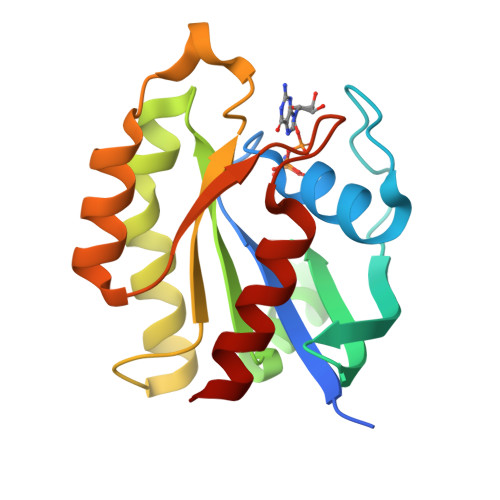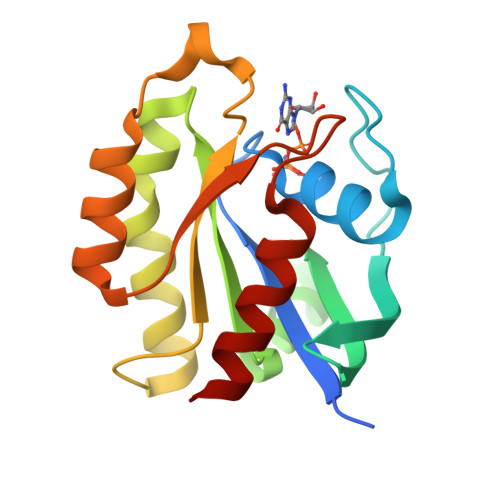Crystal Structure of M-Ras Reveals a GTP-bound "Off" State Conformation of Ras Family Small GTPases
Ye, M., Shima, F., Muraoka, S., Liao, J., Okamoto, H., Yamamoto, M., Tamura, A., Yagi, N., Ueki, T., Kataoka, T.(2005) J Biological Chem 280: 31267-31275
- PubMed: 15994326
- DOI: https://doi.org/10.1074/jbc.M505503200
- Primary Citation of Related Structures:
1X1R, 1X1S - PubMed Abstract:
Although some members of Ras family small GTPases, including M-Ras, share the primary structure of their effector regions with Ras, they exhibit vastly different binding properties to Ras effectors such as c-Raf-1. We have solved the crystal structure of M-Ras in the GDP-bound and guanosine 5'-(beta,gamma-imido)triphosphate (Gpp(NH)p)-bound forms. The overall structure of M-Ras resembles those of H-Ras and Rap2A, except that M-Ras-Gpp(NH)p exhibits a distinctive switch I conformation, which is caused by impaired intramolecular interactions between Thr-45 (corresponding to Thr-35 of H-Ras) of the effector region and the gamma-phosphate of Gpp(NH)p. Previous 31P NMR studies showed that H-Ras-Gpp(NH)p exists in two interconverting conformations, states 1 and 2. Whereas state 2 is a predominant form of H-Ras and corresponds to the "on" conformation found in the complex with effectors, state 1 is thought to represent the "off" conformation, whose tertiary structure remains unknown. 31P NMR analysis shows that free M-Ras-Gpp(NH)p predominantly assumes the state 1 conformation, which undergoes conformational transition to state 2 upon association with c-Raf-1. These results indicate that the solved structure of M-Ras-Gp-p(NH)p corresponds to the state 1 conformation. The predominance of state 1 in M-Ras is likely to account for its weak binding ability to the Ras effectors, suggesting the importance of the tertiary structure factor in small GTPase-effector interaction. Further, the first determination of the state 1 structure provides a molecular basis for developing novel anti-cancer drugs as compounds that hold Ras in the state 1 "off" conformation.
Organizational Affiliation:
Division of Molecular Biology, Department of Molecular and Cellular Biology, Kobe University Graduate School of Medicine, 7-5-1 Kusunoki-cho, Chuo-ku, Kobe 650-0017, Japan.


















